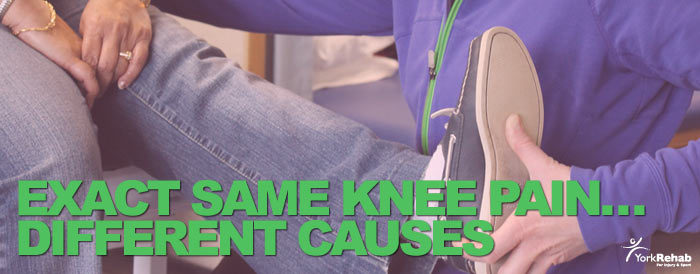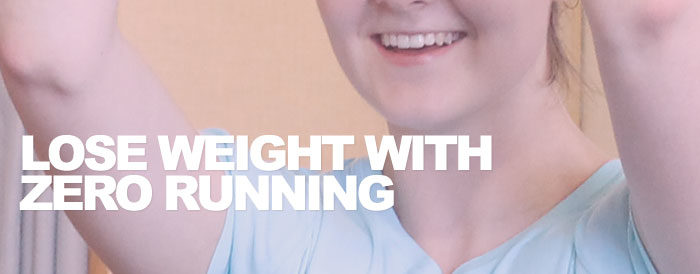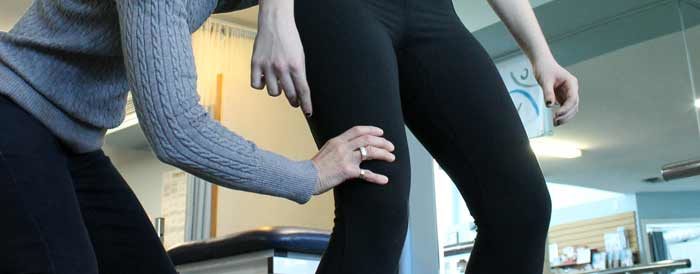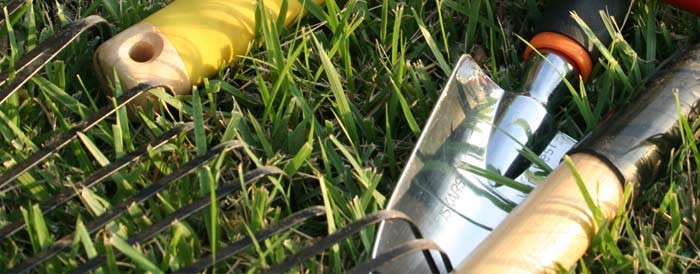Knee Pain
Is Chronic Pain something you live with forever? The Answer may surprise you.
Do you have a bum shoulder? A bad knee? Do you have a pain from an injury that has persisted for months or years? You may have talked to friends or co-workers about it and likely heard “Oh that’s chronic pain and it’s something you just live with” or “Well, what do you expect, you’re getting older”. Many people who develop such pains assume that because their injury was a long time ago, their pain is set in stone and there’s nothing you can do about it. Or, as you get older, it will be more difficult to get rid of it. Well, there is hope! These long-lasting pains don’t have to stay around forever; there are several courses of recovery that can take place depending on the nature of the original injury and the natural repair process that has taken place since.
In scenario 1, let’s assume you have pain from an old shoulder injury. It got better initially but just didn’t seem to fully heal, and now you’re left with some lingering pain. Normally what happens during the first few weeks of soft tissue healing (for example with muscle or ligament) is your body deposits scar tissue to rebuild the injured site. If we looked at the tissue fibres under a microscope at this point we would find them disorganized and unlike the original tissue where the fibres are lined up in parallel. If controlled stress (stretching and/or strengthening) is applied to the injured site at this stage, it would begin to remodel and look more like the original tissue. Depending on the severity of the original injury and assuming no other complications, after several more weeks of recovery and exercise the injured site can become pain-free and function well.
However, some people mistakenly believe that a tissue will heal fully on its own with time, or initially they misinterpret the pain that occurs with stressing the injured site and avoid it. In both cases, the remodelling process is not undertaken, and the scar tissue remains disorganized and tight, causing pain every time it is stressed. The good news is if you understand what is happening and are guided through the remodelling process with the assistance of a physiotherapist, you can make changes to this tissue and achieve a gradual recovery over several weeks or months. Typically this will involve an individualized and structured home exercise program – which can involve strengthening and stretching.
In scenario 2, let’s say you find yourself with pain from an old knee injury and no matter how much you try to remodel it following the principles above, the pain doesn’t go away. Sometimes what can happen at the time of injury is the resting position of the joint is disturbed so now it isn’t “hinging” properly anymore. Again, the positive here is this situation can be reversed quickly with the help of a physiotherapist who can identify the right movements to return it to its proper position. It’s like a floor rug being ruffled up in front of a door – when you try to open the door, it gets blocked by the rug. So what you have to do is find the right way to move the rug and then the door will open smoothly again. There are cases where pain that has persisted for years can respond to simple movements rapidly due to this problem.
The bottom line is this: just because you have had pain for months or years from an old injury that seems to be unchanging, it doesn’t mean you’re doomed to live with it. There’s hope! You can simply start by making an appointment with a physiotherapist. They’ll listen to you and do a thorough assessment to determine the nature of the problem, and design a recovery plan for you. Remember, you don’t need a doctor’s referral to book an appointment with a physiotherapist. As long as you’re willing to put in the effort to recover, the results will likely follow. Wouldn’t it be nice to leave behind that nagging pain you thought would be with you for the rest of your life?
Exact Same Knee Pain…Different Causes
When you’re told you need to go see a physiotherapist, what do you think of? You may think of stretching, strengthening, heat/ice, ultrasound, endurance training, balance exercises, or electrical stimulation. All these thoughts fall under the category of treatment. What you may not consider is your physiotherapist as a diagnostician. Therapists who are trained in Mechanical Diagnosis & Therapy, also known as the McKenzie Method, are diagnosticians first and foremost. The three cases presented below illustrate this point – all three patients came in with pain in the front of their knees, but the underlying reason for each pain was different and demanded unique management strategies.
The first patient was a 14-year-old female who had right knee pain episodically for the past 2 years – at the time of assessment she had it for 1 month. It was painful when bending, standing, squatting, lunging, and sometimes when sitting, walking, and negotiating stairs, and prevented her from participating in karate. The history and physical exam indicated it could be a typical knee problem, but in the McKenzie Method the lumbar spine (lower back) is first assessed for any contribution – spinal conditions can refer in unusual ways to the extremity. Ultimately it was found that repetitive lumbar extension brought about relief from her knee pain, which she was easily able to do at home, and after some reconditioning exercises, she made a full return to karate.
The second patient was a 60-year-old male who had pain in both knees for a year after a day of heavy ladder use at work. The pain was there mostly when getting out of a chair and walking the first few steps, and also sometimes with squatting. As with the patient above, his lower back was assessed for any contribution and was ruled out because of no change to his presentation. His knees were then assessed with repetitive movement testing. Repetitive straightening (hyperextension) caused a significant reduction in his squatting pain. Within a week of performing this exercise 4-5 times per day, he was 90% free of pain with full movement and strength.
The third patient was a 39-year-old male who had right knee pain intermittently for 2 years after doing some moving; going up and down stairs and squatting were his two most painful activities. As above, his lumbar spine was assessed first, which had no effect on his presentation, so it was ruled out. Repeated knee movements also had no lasting effect but it was found that repetitive straightening of his knee with an ankle weight consistently produced his pain. This pain did not remain afterward. This presentation is consistent with a dysfunction or suboptimal healing of the patellar tendon. Consistent remodeling of his tendon via progressive resistance exercises over two months proved to steadily diminish his pain. He was able to go up and down stairs without pain at that point and had made a return to biking.
The three cases outlined above all had frontal knee pain, but for different reasons: one was due to a lower back joint problem, one was due to a knee joint problem, and the last was the result of a patellar tendon dysfunction. These diagnoses were sorted out following the principles of the McKenzie Method and each patient was given an effective self-management strategy that led to resolution of the problem. Make sure the next time you need to see a physiotherapist that you are given a good mechanical assessment that focuses on understanding the cause of your problem, and not just what can be done to treat the symptoms.
Our Newmarket Physiotherapy clinic has several physiotherapists trained as McKenzie Method practitioners. Our physio clinic also has 2 of only a handful of therapists in Canada who have completed the Diploma Program in Mechanical Diagnosis and Therapy (MDT) and the most number of credentialed therapists in an Ontario clinic.
4 Exercises to Help You Lose Weight with Zero Running
The average person believes running is the best exercises for losing weight. And while running provides a good workout, it may not be for everyone. For those that do not like running or find it difficult to do, there are other exercise options that can burn calories to help you lose weight.
So for your next workout, skip the treadmill and try:
1. Jumping Rope:
Did you know jumping rope uses more muscle groups than running, or that ten minutes of jumping rope burns the same amount of calories as running an eight-minute mile? Yup, this simple exercise is just as effective as running. Plus it challenges your endurance, balance, and coordination while adding definition to your calves and shoulders. Aim to do 10 – 20 minutes of jumping rope to reap these benefits.
2. Indoor Rock Climbing:
This fun activity combines cardiovascular exercise with resistance training and can burn up to 500 calories in just half an hour. An indoor climbing wall allows for proper skill development and confidence building since everyone climbs with the support of a harness. Thanks to rock climbing’s recent popularity, finding an indoor facility has never been easier. If you’re looking for a rock climbing option in Newmarket consider Of Rock and Chalk (note: York Rehab has no affiliation with this company nor are we endorsing it, ensure that you evaluate any fitness facility thoroughly before using to ensure the proper safety and maintenance practices are in place, qualified staff are available to assist you and that you feel comfortable in the space).
3. Rowing:
Rowing could be considered the perfect exercise because it works all the main muscles – thighs, back, abs and arms. While it is a lower impact workout compared to running, it still delivers a decent burn of up to 420 calories in half an hour. Best of all, the rowing machine at your gym will likely have no line up, so there’s no waiting to start your workout.
4. Burpees:
This classic calisthenic will get your heart rate up in a hurry while toning your arms, legs and core. Burpees are the perfect on-the-go exercise because no equipment is needed and can be done anywhere. Are you wondering how to do a burpee? No problem! Here’s how:
Stand with your feet hip-width apart, knees slightly bent. Swing both arms back and jump straight up into the air. Land softly on your toes and lower into a squat and place both hands on the floor. Jump your feet back into a plank position with your hands under your shoulders. Lower your chest down to perform a push-up. Jump both feet back in and return to starting position. Repeat. Continue to do as many reps as possible – burpees are hard work so don’t be discouraged if you can only manage a few. As your endurance develops work your way up to as many as you can in a minute.
Try including one of these activities in your existing fitness routine to keep your workouts interesting and challenge your body so you continue to lose weight. Haven’t exercised in a while or never tried these exercises? Remember to check with a physiotherapist or physician before beginning a new exercise routine.
5 Quick Ways to Avoid Knee Pain
Knees are the most commonly injured joints in the body and for some simply walking can cause pain. Knee pain is often caused when the muscles of the leg are weak – quadriceps (front of thigh), hamstrings (back of thigh) and gluteal (buttocks).
Weakness in any of these muscles can lead to an imbalance in your knees. But when the muscles of your leg are strong, it keeps the knee in alignment and relieves some of the pressure in your knees. The best way to strengthen your knees is to develop these muscles.
Even if you are already experiencing knee pain, it is not too late to strengthen your legs.Performing resistance exercises will strengthen the weak muscles, ease your knee pain and decrease your chances of sustaining a knee injury. Resistance bands are an inexpensive and beginner friendly way to incorporate resistance into your exercises and develop muscles.
5 Exercises To Strengthen Legs and Keep Knee Pain Away:
- Side Steps: Tie the ends of a resistance band together to form a loop. Place the loop around your legs, secured below your knees. Bend your knees slightly and place your feet hip-width apart. Take a step to the right until the band provides some resistance.
Bring your left foot in towards your right foot, returning to the starting stance. Continue sidestepping to your right for 15 steps and then take 15 steps to the left. - Monster Walk: Loop the resistance band around your legs and secure below your knees. Bend your knees slightly and place your feet hip-width apart. Step forward and to the side at a 45 degree angle with your right foot. Remember to keep the bend in your knees. Now step forward and to the left at a 45 degree angle. Continue alternating steps to the right and left on a 45 degree angle for 30 steps.
- Hamstring Curls: Holding on to the back of a chair or counter, place your feet shoulder width apart. Loop the resistance band around your ankles and without moving your hips, bend your right knee and bring your heel up towards your buttocks. Hold for 5 seconds and then slowly lower your leg. Complete 15 repetitions and then switch legs.
- Lateral Leg Raise: Lay on your right side with your legs extended out and stacked one atop the other. Loop the resistance band around your ankles. Slowly lift your left leg up, until you meet resistance in the band. Lower your leg and return to the starting position. Complete 15 repetitions and then switch sides.
- Bridge: Lie on your back with feet flat on the floor, bending your knees to 90 degrees. Loop the resistance band around your legs, just above your knees. Raise your hips until your shoulders, hips and knees align. Hold for 5 seconds, lower hips slowly to floor. Do 15 repetitions.
Remember to keep the movements slow and controlled. Think about contracting the muscles.
Complete 3 sets of each exercise and rest as needed between sets. Aim to do the exercises two to three times a week to help strengthen your knees.
These exercises are meant to help strengthen your legs and should not hurt. If you experience any pain in the muscles or joints when exercising, you should stop that exercise.
Looking for a customized exercise plan or guidance on how to perform these exercises? You can book an appointment with one of the physiotherapists at York Rehab’s Newmarket Physio Clinic. They can assess your injury, offer a treatment plan for rehabilitation and share advice on injury prevention.
Gardening IS Exercise Too
Gardening is usually looked at as a task instead of actual exercise, and the thought of it being the kind of activity with risk of injury is often the furthest thing from our mind. But GARDENING IS EXERCISE and can pose significant risk of injury due to stress on your shoulders, arms, back, hips and knees. Muscles and joints are also susceptible to due to the repetitive strain and extended periods of fixed positioning (kneeling, bending, etc.).
There are a few things that you can do to protect yourself from injury and as you prepare for your next gardening project:
1. Don’t rush…spread out the work: instead of trying to cram everything into one weekend, take two or three weekends to work on your project. Unlike those “DIY” TV Shows that have teams in the background working to turn around a big project in a couple days…you don’t have that same support so don’t aim for an overnight transformation.
2. Warm up before activity: gentle stretches and movement mimicking the type of activity you’re about to perform is an excellent way of preparing your body for the upcoming work session.
3. Use the right tools: finding tools that are ergonomic can help to relieve some of the stress on joints and muscles. Look for tools that have padded handles and spring-action features (i.e. self opening sheers). Gardening gloves with a rubber grip are also recommended. Such gloves produce a better grip, allowing less effort when holding tools which reduces muscle strain.
4. Remember technique: don’t discount the benefits proper of technique…it can make a job much easier. When lifting heaving objects (flower pot, bags of soil, decorative stones, etc.), remember to lift with your legs (not your back). And when doing repetitive work like raking, remember to keep feet shoulder width apart, use your shoulders as much as possible(and minimize bending your back), switch leg and arm positions regularly and avoid twisting your body (reposition your feet in the direction you’re extending).
The whole idea behind a beautiful garden is that you get to spend time it – the last thing you want is to be stuck inside recovering from a preventable injury. So remember these points to keep away from injury. Happy gardening!






